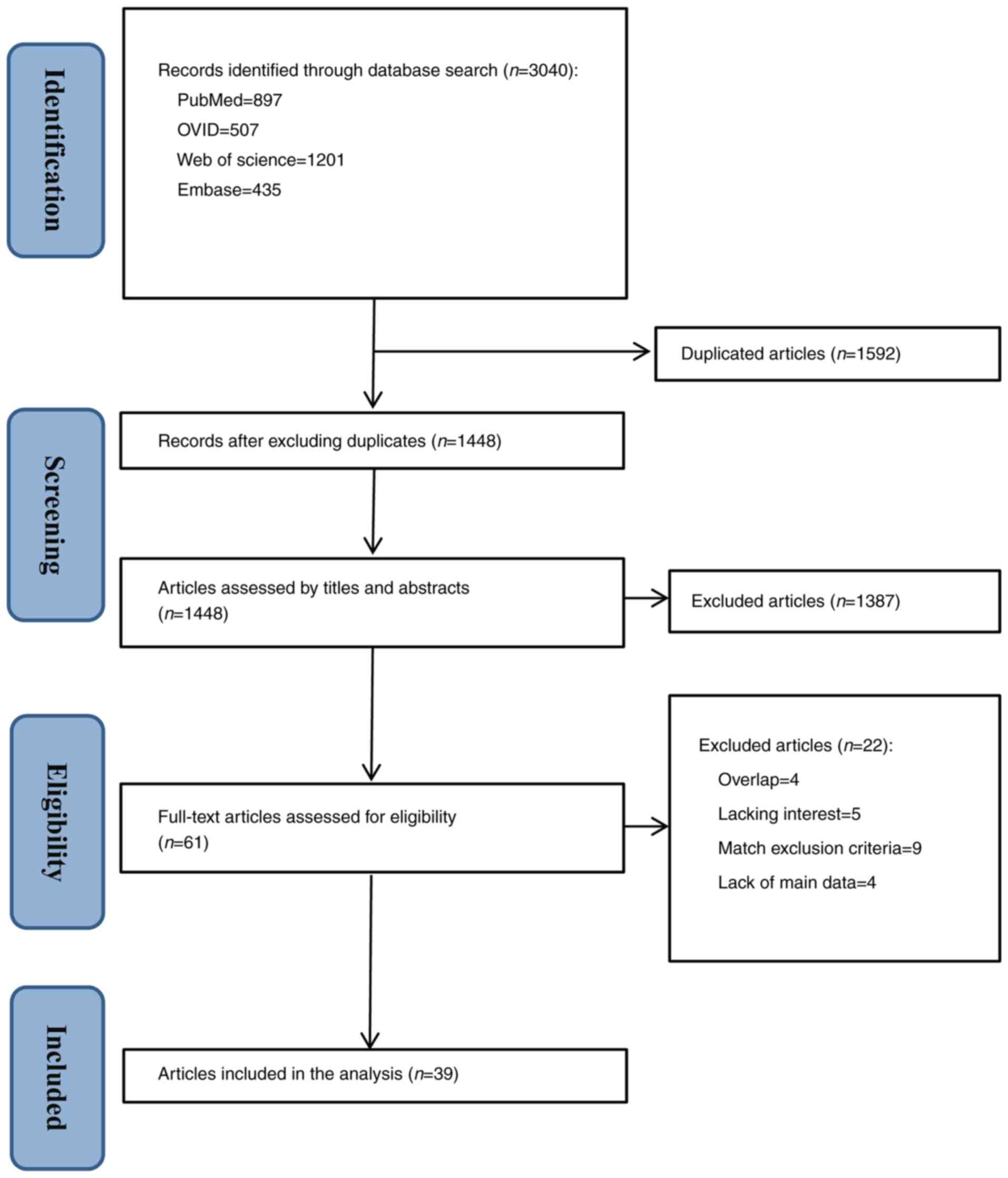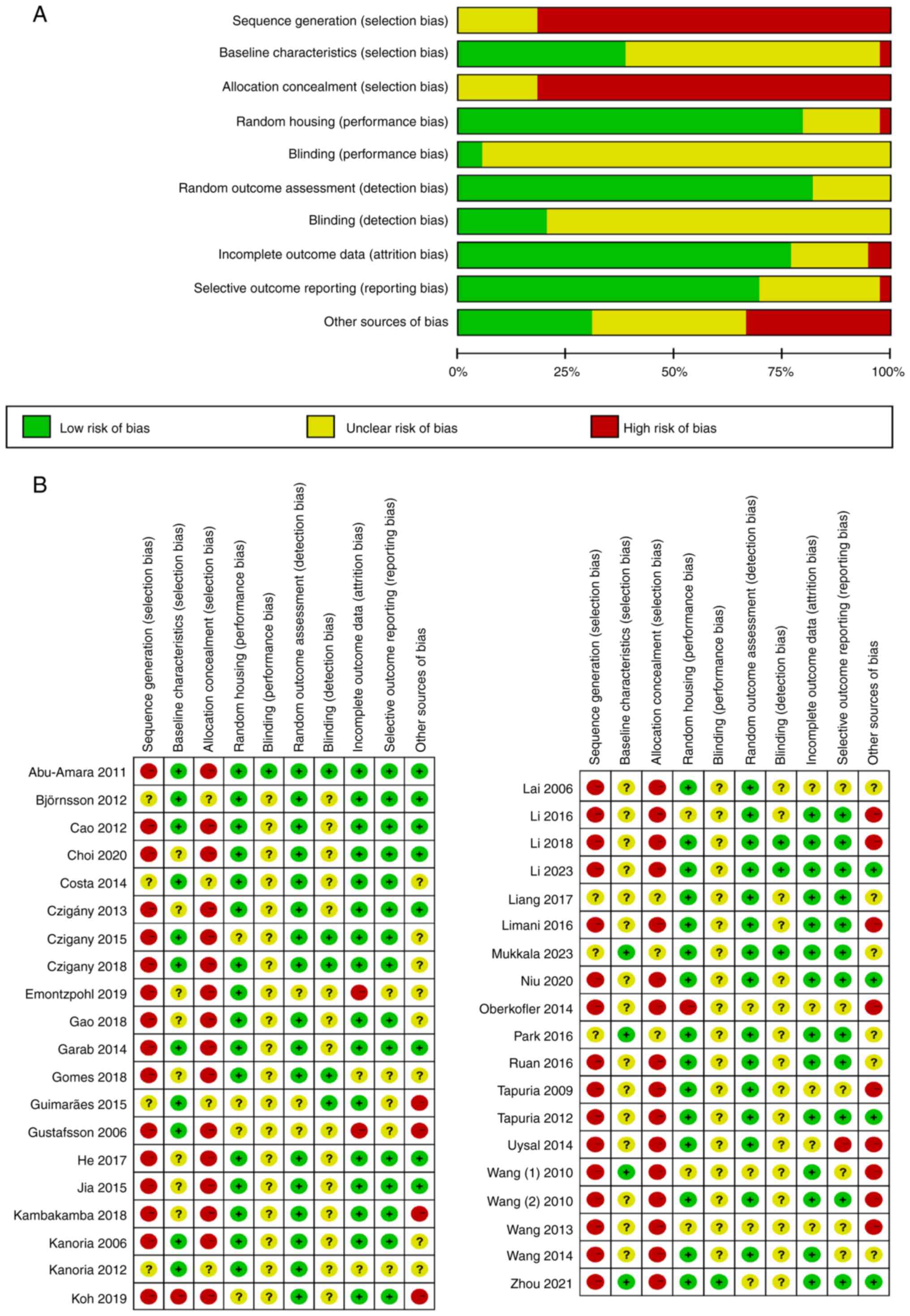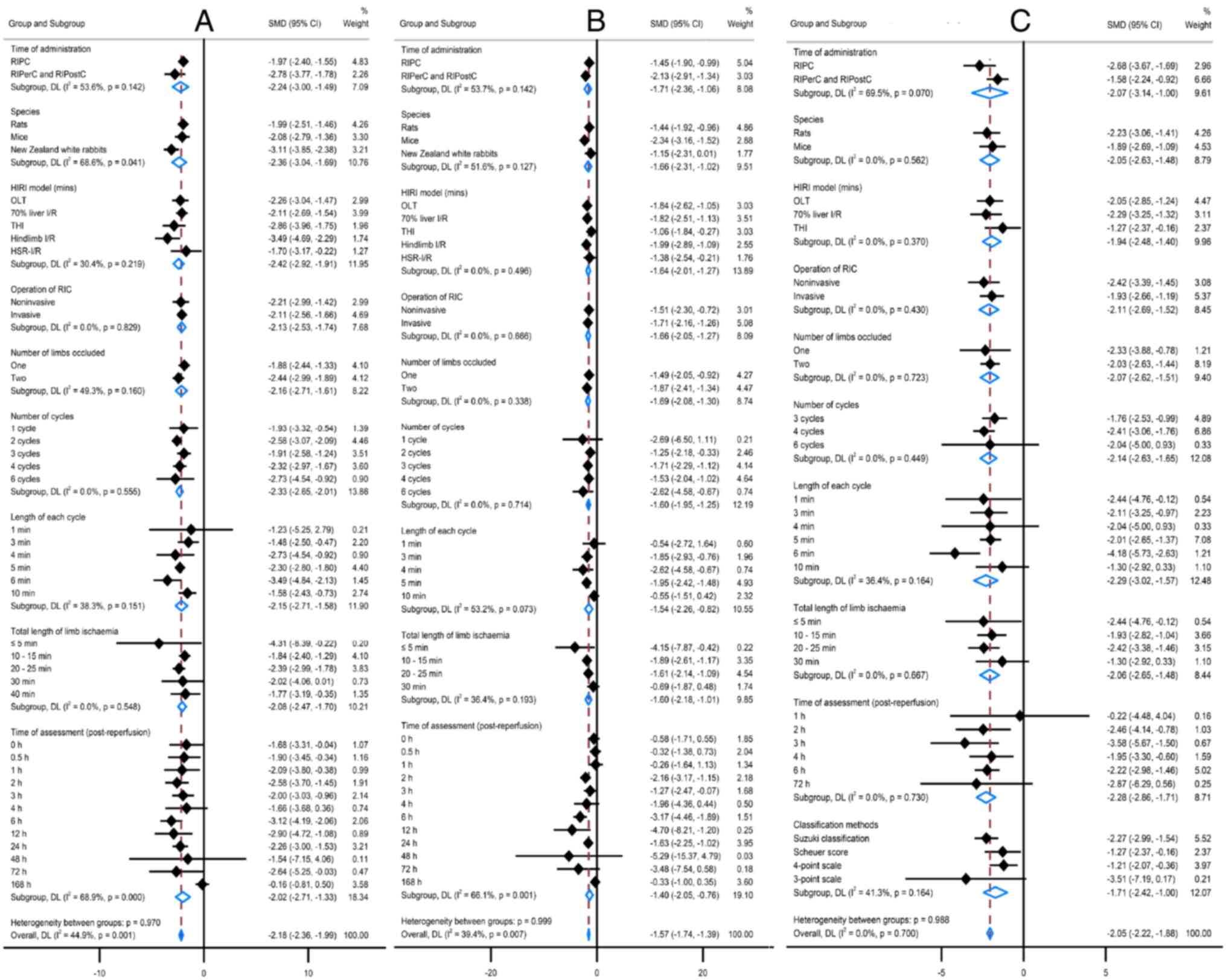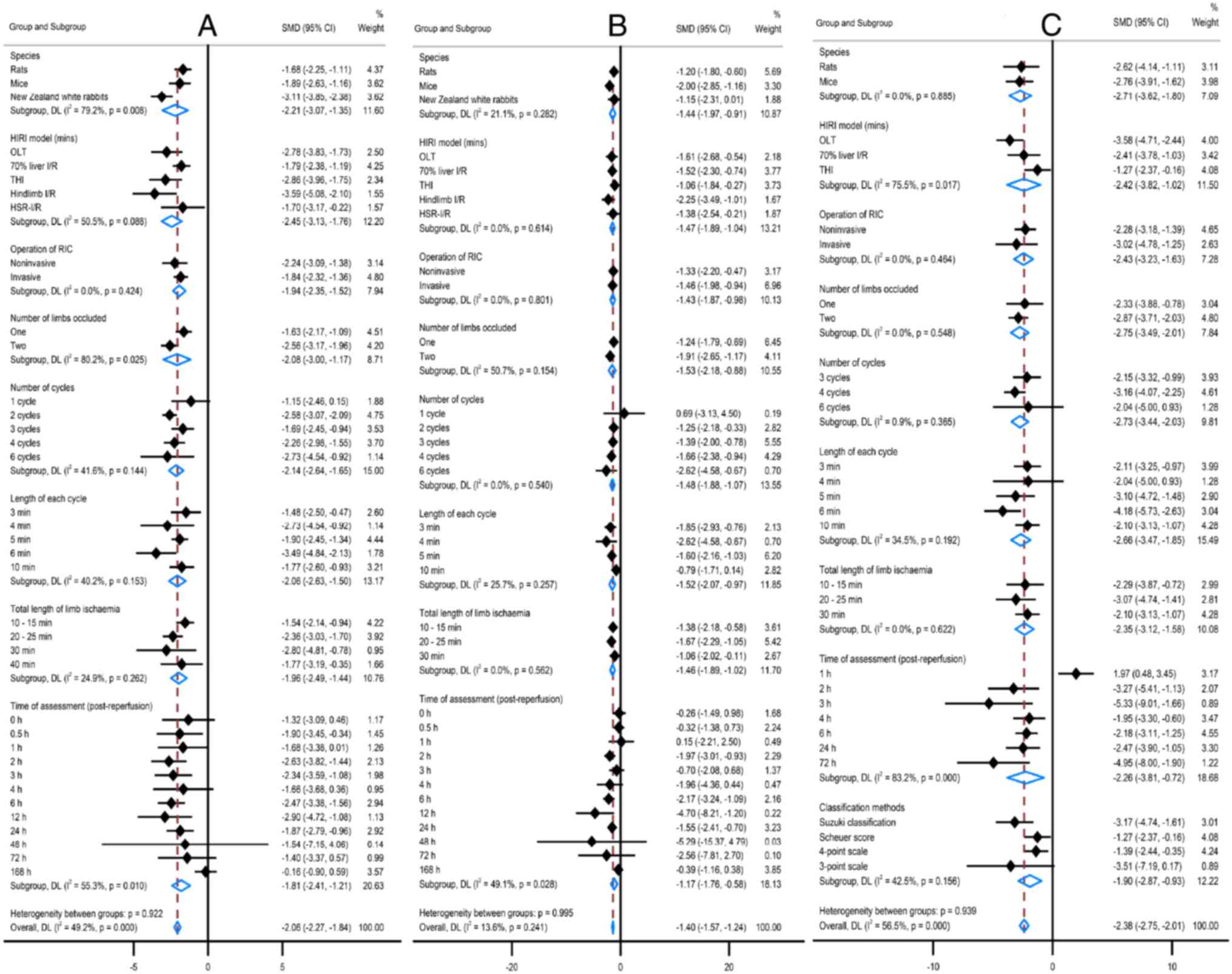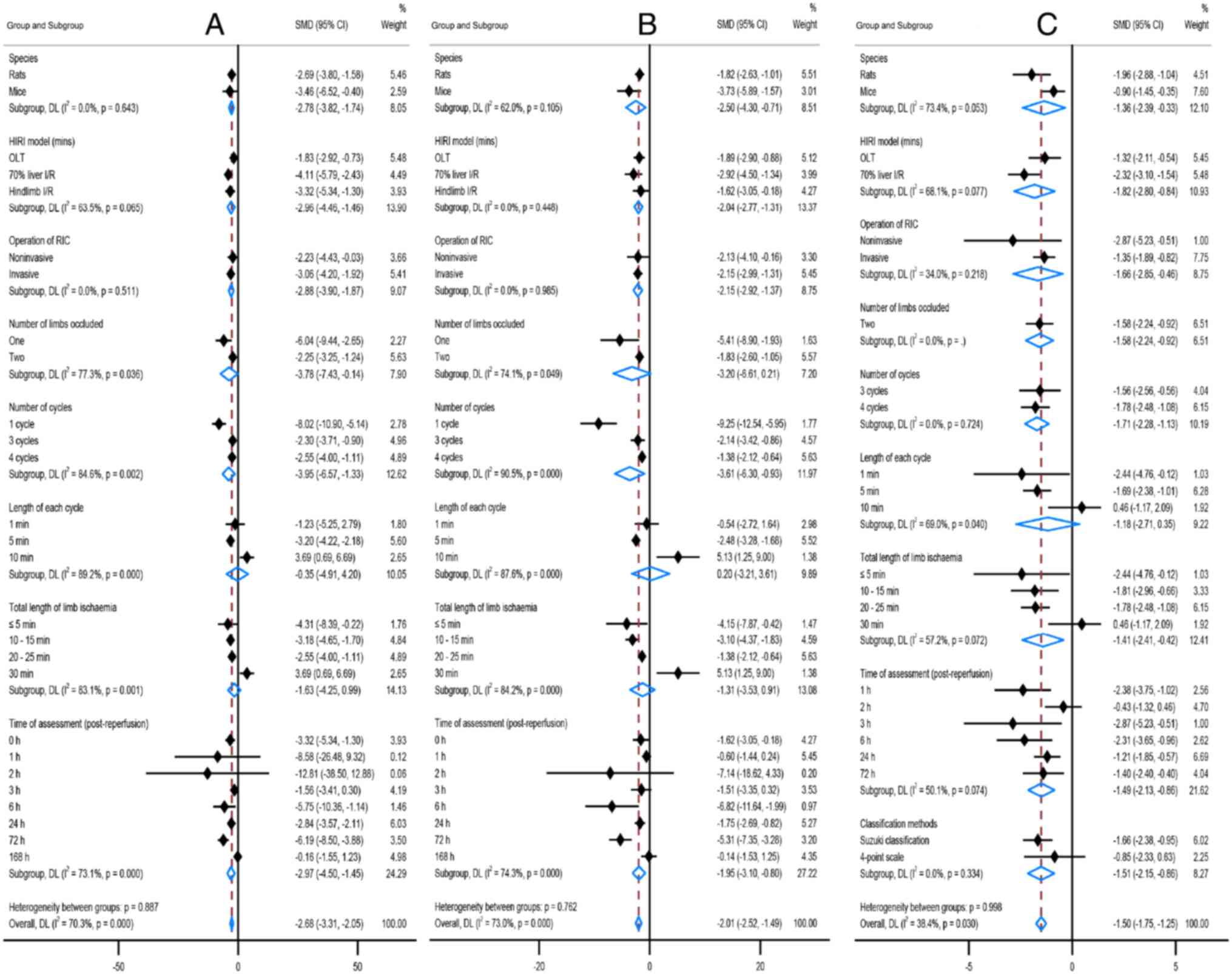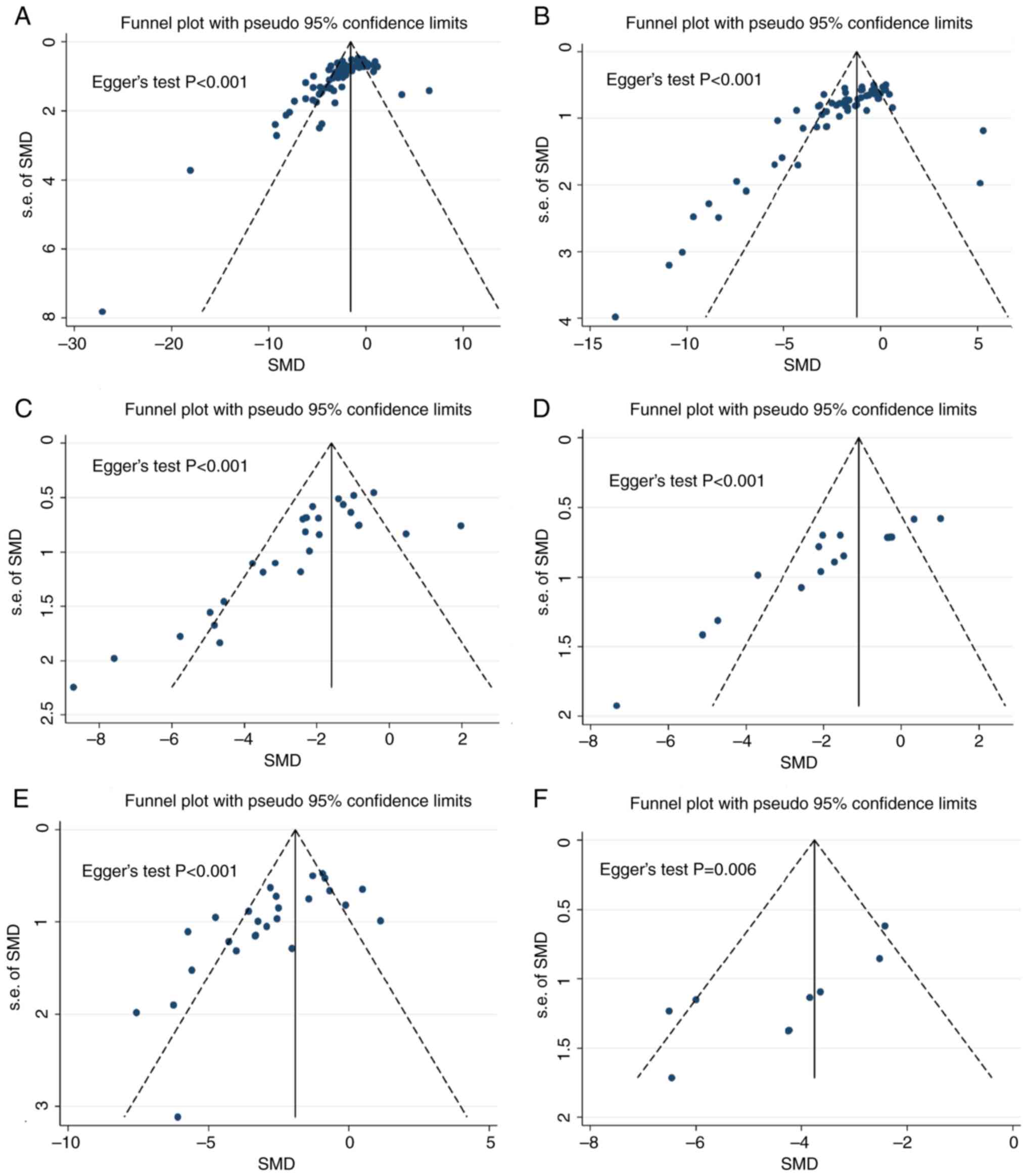Remote ischemic conditioning in experimental hepatic ischemia‑reperfusion: A systematic review and meta‑analysis
- Authors:
- Published online on: January 21, 2025 https://doi.org/10.3892/br.2025.1927
- Article Number: 49
-
Copyright: © Tian et al. This is an open access article distributed under the terms of Creative Commons Attribution License.
Abstract
Introduction
Ischemic conditioning intervention therapy originated for the management of cardiovascular diseases in the 1980s, conferring cardiac protection from a subsequent or ongoing ischemia-reperfusion injury (IRI) (1). Subsequently, organ protection in brain and liver diseases has also been investigated, but its apparent preclinical benefits have not been consistently translated into clinical practice (2,3). Remote ischemic conditioning (RIC) can activate ischemia tolerance through transient, non-fatal induction of remote or limb ischemia by simply inflating a blood pressure cuff on a leg or arm (4). This highly attractive treatment strategy is beneficial in terms of economy, safety, non-invasion and ease of promotion.
RIC, including three types of pre-conditioning (RIPC, before the ischemic event), per-conditioning (RIPerC, during the ischemic event) and post-conditioning (RIPostC, after the ischemic event) based on the timing of induction, has shown promise in treating several cardiovascular and cerebrovascular diseases (5,6). RIC protects the liver from IRI via several mechanisms such as neuro-humoral, mitochondrial autophagy and exosomal gene mechanisms (4). Although RIC has a strong short-term hepatoprotective effect against hepatic ischemia-reperfusion injuries (HIRIs) during liver-related surgeries, it is neutral in improving long-term outcomes such as hepatocyte apoptosis index, duration of hospital stay and survival rate (2). The potential explanation is interactions with liver-protecting anesthetics.
Although RIC does not cause harm in patients undergoing liver-related surgery and has elevated to human trials, human clinical evidence is limited. Importantly, there are still several unanswered questions about the optimal timing of intervention and administration protocols (such as one compared with two limbs and the number and duration of cycles, among others). Therefore, the preclinical evidence on RIPreC, RIPerC and RIPostC in the HIRI models was systematically reviewed and meta-analyzed in the present review to provide constructive and helpful information for future works.
Materials and methods
This systematic review was prepared in accordance with the recommendations of preferred reporting items for systematic reviews and meta-analyses (PRISMA) to assess the methodological quality. Preclinical (non-human) studies were included to compare the effects of RIC on HIRI animal models. This systematic review has been registered with PROSPERO, registration number: CRD42023482725.
Search strategy
A comprehensive literature search was conducted on July 26, 2024 using the PubMed (https://pubmed.ncbi.nlm.nih.gov), OVID (https://ovidsp.ovid.com), Web of Science (https://clarivate.com) and Embase databases (https://www.embase.com) for articles published from the inception to July 2024. Search terms comprised various combinations of ‘remote ischemic conditioning’ or ‘limb ischemic conditioning’ or ‘remote ischemic treatment’ or ‘remote ischemic adaptation’ or ‘remote ischemic preconditioning’ or ‘distant ischemic preconditioning’ or ‘limb ischemic preconditioning’ or ‘remote ischemic perconditioning’ or ‘limb ischemic perconditioning’ or ‘remote ischemic postconditioning’ or ‘limb ischemic postconditioning’ or ‘RIC’ or ‘RIP’ or ‘RIPC’ or ‘RPC’ or ‘RIPerC’ or ‘IperC’ or ‘RPostC’, ‘hepatic ischemia-reperfusion’ or ‘liver graft’ or ‘liver transplantation’ or ‘liver resection’ or ‘hepatectomy’. The search terms were adjusted according to different search engines. There were no language restrictions for the articles that were included. In addition, the authors manually searched the references of included studies and other existing meta-analyses to obtain more eligible studies. A specific search strategy is presented in Table SI.
Inclusion and exclusion criteria
The authors CT and AW independently reviewed and retrieved the full-text articles simultaneously. Different views were discussed among all authors, and duplicate articles in all databases were merged. The latest and most complete study was included when duplicate studies were from the same population.
The inclusion criteria are as follows: i) Any non-human species, any sex, in the models of hepatic ischemia-reperfusion; ii) interested intervention was limb RIC compared with the control group without RIC; iii) controlled studies with a separate control group; and iv) interested outcomes were postoperative liver synthetic function and liver histopathological injury.
The exclusion criteria are as follows: i) Human subjects, in vitro or computer studies; ii) retrospective or single-arm studies; iii) case studies, cross-over studies, studies without a separate control group, editorials, meta-analyses and reviews; iv) only the abstract of a study was available; and v) no reports of postoperative aminotransferase levels or data were from review articles.
Data extraction
The authors CT and AW independently extracted data from each article. Any disagreements were resolved by the consensus of a third reviewer (YK). The following information was extracted from the included articles: First author; year of publication; country or region of studies; animal model (species, sex, sample size, the method of ischemic induction, the duration of ischemia); parameters of RIC (body part, unilateral or bilateral, number of cycles per treatment, duration of occlusion and release per cycle) and interested outcomes. The published graphs were enlarged and measured using Grab software (2) if the information was unavailable in the text. If data were not reported or unclear, the reviewers tried to contact the respective study authors by e-mail (maximum of two attempts). Furthermore, it should be stated that it was impossible to separate the RIPerC and RIPostC groups easily; hence, these were combined to form one group.
Quality assessment
The included animal model studies were assessed using the risk of bias tool of the SYstematic Review Centre for Laboratory animal Experimentation (SYRCLE). This assessment was performed independently by CT and AW. Any disagreements were resolved by consensus. Categories for the quality investigation included sequence generation, baseline characteristics, allocation concealment, random housing, blinding for the performance bias, random outcome assessment, blinding for the detection bias, incomplete outcome data, selective outcome data and other sources of bias. Each category was classified as high, low or uncertain risk.
The methodological quality of the results was evaluated using the Grades of Recommendation, Assessment, Development, and Evaluation (GRADE) guidelines (2). Ultimately, the quality of evidence for each outcome was rated as high, moderate, low or very low.
Primary and secondary outcomes
The primary outcomes evaluated in this study were those directly related to liver injury, such as alanine transaminase (ALT), aspartate transaminase (AST) and liver histopathology. The secondary outcomes assessed were lactate dehydrogenase (LDH), tumor necrosis factor-α (TNF-α), interleukin (IL) -6, IL-10, IL-1β, apoptosis and other possible outcomes.
Statistical analysis
The analysis was performed using the Review Manager version 5.4 software (The Nordic Cochrane Center; The Cochrane Collaboration, 2020). The continuous outcomes were reported as standardized mean difference (SMD) with 95% confidence interval (CI). The dichotomous outcomes were presented as odds ratio (OR) with 95%CI, and the random-effects model was used for analysis. Subgroup meta-regression or sensitivity analyses were then performed using Stata/MP (version 17.0; StataCorp LLC), and descriptive analysis was conducted if meta-analysis was inappropriate. Publication bias was assessed using Egger's linear regression test. P<0.05 was considered to indicate a statistically significant difference.
Results
Study characteristics
The reviewers initially identified 3,040 relevant articles, of which 1,592 were duplicates. Excluding duplicates, a total of 1,448 studies were left for analysis. After analyzing the titles and abstracts, 1,387 articles that did not fulfil the criteria were also excluded, and the remaining 61 studies were selected for a full reading. After reviewing the full texts, 39 animal model studies met the eligibility criteria for data synthesis (Fig. 1).
All 39 included articles/studies (101 animal experiment records) were published between 2006 and 2023 and conducted in 10 countries (China, n=15; United Kingdom, n=5; Brazil, n=3; Korea, n=3; Hungary, n=3; Switzerland, n=3; Germany, n=2; Canada, n=2; Sweden, n=2; and Turkey, n=1). In total, 32 of 101 animal experiments studied Sprague Dawley rats (n=337), 12 used Wistar rats (n=178), 16 tested Lewis rats (n=144), 28 examined C57BL/6 mice (n=270), five used wild-type mice (n=82) and eight studied New Zealand white rabbits (n=50). To induce HIRI, various animal models, such as orthotopic liver transplantation (OLT), 70% liver I/R, total hepatic ischemia (THI), hemorrhagic shock-resuscitation (HSR) I/R or hindlimb I/R, were used. RIC was primarily performed by occluding the femoral vascular bundle, femoral artery or hind limbs. Table I summarizes the experimental characteristics of all the involved studies (7-45).
Quality assessment
The SYRCLE's risk of bias tool was used to evaluate the risk of bias in the included animal experiments studies (Fig. 2). In quality assessment, 15 studies (7,9,18,22,26,27,31,32,36-40,44,45) were analyzed with the same baseline characteristics among groups, but none of them conducted random sequence generation or allocation concealment. A total of 30 studies (7-12,14,15,17-28,31,32,34,35,37-41,44) had complete outcome data and they also demonstrated a low risk of attrition and reporting biases. Furthermore, blind bias could not be evaluated in most studies because of the characteristics of animal experiments.
Effects of all RIC studies
RIC was significantly effective against all the primary outcomes (ALT, AST and liver histopathology; all P<0.00001), although there were significant statistical heterogeneities: I2=79% in the ALT change, 76% in the AST change, and 71% in the liver histopathology change (Table II; Fig. S1, Fig. S2 and Fig. S3). Notably, RIPerC/RIPostC exhibited greater effects on ALT and AST changes [ALT SMD (95%CI): RIPC -1.97 (-2.40, -1.55) vs. -2.78 (-3.77, -1.78); P=0.142; AST SMD (95%CI): RIPC -1.45 (-1.90, -0.99) vs. -2.13 (-2.91, -1.34); P=0.142], and RIPC exerted a greater effect on liver histopathology change [SMD (95%CI): RIPC -2.68 (-3.67, -1.69) vs. -1.58 (-2.24, -0.92); P=0.070]; however, there was no interactions between the two groups in the meta-regression analysis. RIC was the greatest magnitude effective if the duration of each cycle was 4-6 min or the total duration of limb ischemia was 10-25 min. ALT and AST changes significantly interacted with the assessment times, with two peaks occurring 2-3 or 6-12 h post-reperfusion lasting up to 72 h. The efficacy of RIC on ALT change was greatest in the New Zealand white rabbits model with species interaction (P=0.041), but this animal model was much fewer (n=150). In addition, there were no interactions between liver histopathology and species, the HIRI model, the operation of RIC, the number of limbs occluded, the number of cycles, the duration of each cycle, the total duration of limb ischemia, or classification methods of liver histopathology score in the meta-regression analysis (all P>0.05). The details are shown in Table II and Fig. 3.
RIC was also significantly effective against several secondary outcomes such as LDH, TNF-α and apoptosis index (all P<0.00001) and there were also significant statistical heterogeneities (I2=75%, I2=76%, I2=51%, respectively; Table SII; Fig. S4). Due to the limitations of the sample size and data integrity, only a meta-regression analysis was performed by dividing the groups of RIPC and RIPerC/RIPostC, and there were no interactions between the two groups (P=0.91, P=0.16, P=0.75, respectively; Fig. S5). In addition, only four studies (five experiments; 78 animals) (7,12,21,26) evaluated IL-6 change, and five studies (13 experiments; 156 animals) (10,12,18,21,26) evaluated IL-10 change, showing that RIC was ineffective against IL-6 and IL-10 changes [SMD (95%CI): -1.47 (-3.72, 0.79); P=0.20; SMD (95% CI): -0.34 (-1.39, 0.71); P=0.52].
Effects of RIPC studies
The effects of RIPC protocol variables were assessed against the primary outcomes changes using meta-regression (Fig. 4). The effects of RIPC on ALT and AST changes were significant if the duration of each cycle was 6 min or the total duration of limb ischemia was 10-25 min, with two peaks occurring at 2-3 or 6-12 h following reperfusion and lasting up to 72 h. RIPC was most effective against ALT change in New Zealand white rabbits and had no interactions in rats or mice (P=0.008). Using one or two limbs of RIPC reduced ALT but using two limbs was significantly improved than one limb [SMD (95%CI): -2.56 (-3.17, -1.96) vs. -1.16 (-2.17, -1.09); P=0.025]. In addition, the effect of RIPC on the liver histopathological change was improved in the OLT model (P=0.017), and there were no interactions between RIPC and the liver histopathological score classification method (P=0.156).
Effects of RIPerC/RIPostC studies
The effects of RIPerC/RIPostC protocol variables were assessed against the primary outcomes changes using meta-regression (Fig. 5). Similar to the RIPC protocol, the protective effects against ALT and AST changes revealed two peaks, but the first peak occurred earlier (1-3 h post-reperfusion). The efficacies of RIPerC/RIPostC on ALT and AST interacted with the RIC cycles, the most significant at one cycle of RIC (P=0.002; P<0.001), but this animal model is much fewer (n=24). Using one or two limbs of RIPerC/RIPostC reduced ALT and AST, but using one limb was a significant improvement on two limbs [ALT SMD (95%CI): -6.04 (-9.44, -2.65) vs. -2.25 (-3.25, -1.24), P=0.036; AST SMD (95%CI): -5.41 (-8.90, -1.93) vs. -1.83 (-2.60, -1.05), P=0.049]. Notably, the protection was ineffective if the duration of each cycle was 10 min or the total duration of the limb occlusion was 30 min.
Publication bias
Notably, Begg's funnel plot (Fig. 6) shows the asymmetric patterns in included studies, suggesting a possible publication bias in this meta-analysis (All Begg's statistics P<0.05). Further analyzing the sources of statistical heterogeneity revealed the presence of interactions with respect to country. The protective effects of RIC on ALT and AST changes were highest in Brazil and the impact on liver histopathology was highest in Korea (Fig. S6).
Discussion
HIRI is a complex pathophysiological process, which is essentially a series of inflammatory cascade reactions triggered by the release of a large number of inflammatory mediators following the activation of hepatic Kupffer cells, hepatic sinusoidal endothelial cells and hepatic stellate cells, which may lead to the postoperative liver dysfunction and partial residual liver cell death, or even an increase of perioperative mortality (46,47). Various strategies such as pharmacological modifiers, physiological scavengers and physical processes have been investigated to avoid the adverse effects of HIRI following liver transplantation and liver resection (4,48). RIC is one of these novel strategies, which can induce nonlethal stress to the remote organs through transient ischemia, resulting in local and systemic tolerance to IRI. There is too little clinical evidence; however, the role of RIC in animal HIRI models has been extensively studied. To the best of the authors' knowledge, there have been no systematic reviews and meta-analyses related to this topic.
The reviewers carefully set the primary outcomes to ensure that this systematic review and meta-analysis of preclinical studies can be applied to the clinics. Although there is still a lack of a reliable endpoint that can effectively predict the outcome of patients undergoing surgery, most ongoing HIRI clinical trials focus on the markers of liver injury (ALT and AST) as primary outcomes (2). Considering this clinical setting, the present review briefly analyzed the efficacy of RIC on HIRI in preclinical studies with ALT, AST and liver histopathology as the primary outcomes and LDH, TNF-α, and apoptosis index as secondary outcomes. The present systematic review and meta-analysis of 39 articles (101 animal experiments, 1,061 animals) confirmed that RIC (RIPC or RIPerC/RIPostC) had a powerful effect on improving ALT, AST and liver histopathology changes in the preclinical liver I/R models. In all RIPerC/RIPostC studies, ALT and AST changes appeared to be more efficacious than RIPC in both rats and mice, in 70% of liver I/R models and using one or two limbs and using invasive or non-invasive operations. However, RIPC appeared to have a more potent effect on liver histopathology change.
Significant statistical heterogeneities were present in both RIPC and RIPerC/RIPostC groups and the meta-regression subgroup analysis helped to explore the effects of these two protocol variables on the changes in primary outcomes. Significant interactions with species in RIC experiments showed that RIPC was most effective in New Zealand white rabbits. However, the RIPerC/RIPostC group lacked the New Zealand white rabbits' trial, and both groups were equally effective in rats and mice. This interspecies difference has raised concerns about treatment failure when moving into clinical trials. A recent study (2) evaluating the beneficial effects and applicability of RIPC in hepatectomy demonstrates that RIPC has some short-term liver protection against HIRI during hepatectomy but has limited improvement in clinical outcomes.
RIPerC/RIPostC studies revealed significant interactions with the total duration of limb ischemia (defined as the dose of RIC) and RIC was ineffective when the dose was 30 min. The 40-min dose was not tested in the RIPerC/RIPostC group, but the effect began to wane in the RIPC group. However, RIPC studies showed no significant interactions with doses, suggesting the existence of a dose therapeutic window with an optimal period between 10 and 25 min. The number of limbs used for RIC may somewhat reflect the dose. However, the present review showed that RIPC was a significant improvement, compared with unilateral, regarding ALT change on both sides, whereas RIPerC/RIPostC was the opposite. Frustratingly, the reviewers gained no reasonable explanation and heterogeneity or publication bias could not be ruled out. In addition, none of the included studies involved a repeat dose regimen (RIPC+RIPerC/RIPostC), and whether this provides added benefit warrants further verification.
The mechanisms of RIC are still being explored and may involve various inflammatory mediators, receptors, gene expression and other links. Some studies have demonstrated that RIC has two protective time windows (49-51). The first protective time window (also known as the classical protective window) occurs immediately after RIC and has a strong effect. It lasts for 2-3 h and possibly relates to altering endogenous substances (such as adenosine, bradykinin and nitric oxide) produced during RIC. The second window of protection occurs several hours after RIC, and the effect is weak, lasting 72-96 h. This second window of protection may be related to the cell signaling pathway and gene regulation after releasing endogenous substances. In the present review, the two peak levels of RIC action confirmed the protective time window effect of RIC, and the first peak of RIPerC/RIPostC appeared earlier, indicating that it may take effect more quickly.
Although the present meta-analysis provided rigorous information on RIC's efficacy for HIRI, there were still some limitations, suggesting that the results of all outcomes should be interpreted with caution, needing more well-designed preclinical and clinical studies. First, the majority of articles included in this review studied healthy young male rodent models, which may not accurately reflect clinical scenarios involving comorbidities. By contrast, most patients were middle-aged and elderly with one or more comorbidities that may inhibit the effects of RIC, such as hypertension, diabetes, hepatitis B, fatty liver or cirrhosis. Second, anesthesia during RIC implementation is another concern, as propofol or sevoflurane has been reported to have liver protective effects (52,53). All current clinical studies have been conducted under propofol anesthesia or propofol combined with inhalation anesthesia, which may interfere with the effects of RIC and is also a hot topic of debate. Third, for the countries where animal experiments were conducted in this study, the sources of heterogeneity were significant. There was also a substantial risk of publication bias, with a worrying tendency to overinterpret positive results. Fourth, as shown in Table II, the number of experiments on some models and species is small, and some experiments have limited data, so it is difficult to fully consider all animal models and species differences in meta-analysis. Therefore, some species or models were simply merged, such as ‘All rats’ and ‘All OLT’ in Table II and Fig. 3. However, from the statistical data of the present review, these will not affect the main results of this study. Fifth, the optimal frequency and repeated dosing effects remain unclear. RIPC combined with RIPerC/RIPostC or a daily repetition protocol would be a promising exploration. Overall, the present review demonstrated promising preclinical evidence for RIC in HIRI, but its clinical translation requires addressing these limitations. However, it remains a comprehensive review and probably the most accurate preclinical evidence of the literatures to date.
In summary, RIC significantly alleviated HIRI in the experimental models. RIPerC/RIPostC acted more quickly and affected ALT and AST changes, whereas RIPC significantly affected liver histopathology. RIC has a dose therapeutic window and the best period is 10-25 min. However, given the significant statistical heterogeneities and risk of publication bias, future studies using repeated doses in animal models with comorbidities will generate innovative ideas for its therapeutic applications.
Supplementary Material
Forest plot for ALT measurements. ALT, alanine transaminase; RIC, remote ischemic conditioning.
Forest plot for AST measurements. AST, aspartate transaminase; RIC, remote ischemic conditioning.
Forest plot for liver histopathology measurements. RIC, remote ischemic conditioning.
Forest plots for secondary outcomes. Changes in (A) LDH, (B) TNF-α and (C) apoptosis index. LDH, lactate dehydrogenase; TNF-α, tumor necrosis factor-α; RIC, remote ischemic conditioning.
Subgroup analysis of secondary outcomes. Changes in (A) LDH, (B) TNF-α and (C) apoptosis index. LDH, lactate dehydrogenase; TNF-α, tumor necrosis factor-α; RIC, remote ischemic conditioning.
Subgroup analyses of all RIC studies by country. Changes in (A) ALT, (B) AST and (C) liver histopathology. RIC, remote ischemic conditioning; ALT, alanine transaminase; AST, aspartate transaminase.
The search strategy.
Treatment effects of different factors based on secondary outcomes.
Acknowledgements
Not applicable.
Funding
Funding: The present systematic review was funded by the Natural Science Foundation of Yongchuan District, Chongqing, China (Ycstc; grant no. 2020nb0229).
Availability of data and materials
Not applicable.
Authors' contributions
CT was responsible for conceptualization, funding acquisition, data curation and writing the original draft. AW was responsible for validation, data curation, software, supervision, writing, reviewing and editing. YK was responsible for conceptualization, validation, writing, reviewing and editing. Data authentication is not applicable
Ethics approval and consent to participate
The present review was exempted from an ethical opinion by the Ethics Committee of Yongchuan Hospital of Chongqing Medical University as it was a systematic review of the literature.
Patient consent for publication
Not applicable.
Competing interests
The authors declare that they have no competing interests.
References
|
Murry CE, Jennings RB and Reimer KA: Preconditioning with ischemia: A delay of lethal cell injury in ischemic myocardium. Circulation. 74:1124–1136. 1986.PubMed/NCBI View Article : Google Scholar | |
|
Tian C, Wang A, Huang H and Chen Y: Effects of remote ischemic preconditioning in hepatectomy: A systematic review and meta-analysis. BMC Anesthesiol. 24(118)2024.PubMed/NCBI View Article : Google Scholar | |
|
Li Q, Guo J, Chen HS, Blauenfeldt RA, Hess DC, Pico F, Khatri P, Campbell BCV, Feng X, Abdalkader M, et al: Remote ischemic conditioning with medical management or reperfusion therapy for acute ischemic stroke: A systematic review and meta-analysis. Neurology. 102(e207983)2024.PubMed/NCBI View Article : Google Scholar | |
|
Stankiewicz R and Grąt M: Direct, remote and combined ischemic conditioning in liver surgery. World J Hepatol. 13:533–542. 2021.PubMed/NCBI View Article : Google Scholar | |
|
Weir P, Maguire R, O'Sullivan SE and England TJ: A meta-analysis of remote ischaemic conditioning in experimental stroke. J Cereb Blood Flow Metab. 41:3–13. 2021.PubMed/NCBI View Article : Google Scholar | |
|
Zhao W, Hausenloy DJ, Hess DC, Yellon DM and Ji X: Remote ischemic conditioning: Challenges and opportunities. Stroke. 54:2204–2207. 2023.PubMed/NCBI View Article : Google Scholar | |
|
Mukkala AN, Petrut R, Goldfarb R, Beroncal EL, Leung CH, Khan Z, Ailenberg M, Jerkic M, Andreazza AC, Rhind SG, et al: Augmented Parkin-dependent mitophagy underlies the hepatoprotective effect of remote ischemic conditioning used prior to hemorrhagic shock. Mitochondrion. 70:20–30. 2023.PubMed/NCBI View Article : Google Scholar | |
|
Li JH, Jia JJ, He N, Zhou XL, Qiao YB, Xie HY, Zhou L and Zheng SS: Exosome is involved in liver graft protection after remote ischemia reperfusion conditioning. Hepatobiliary Pancreat Dis Int. 22:498–503. 2023.PubMed/NCBI View Article : Google Scholar | |
|
Zhou H, Li L, Sun H, Li H, Wu Y, Zhang X and Zhang J: Remote ischemic preconditioning attenuates hepatic ischemia/reperfusion injury after hemorrhagic shock by increasing autophagy. Int J Med Sci. 18:873–882. 2021.PubMed/NCBI View Article : Google Scholar | |
|
Niu Q, Sun W, Chen Q, Long Y, Cao W, Wen S, Li A, Dong F and Shi H: Protective effects of ischemic postconditioning on livers in rats with limb ischemia-reperfusion via glycogen synthase kinase 3 beta (GSK-3β)/Fyn/Nuclear receptor-erythroid-2-related factor (Nrf2) pathway. Med Sci Monit. 26(e923049)2020.PubMed/NCBI View Article : Google Scholar | |
|
Choi EK, Jung H, Jeon S, Lim JA, Lee J, Kim H, Hong SW, Jang MH, Lim DG and Kwak KH: Role of remote ischemic preconditioning in hepatic ischemic reperfusion injury. Dose Response. 18(1559325820946923)2020.PubMed/NCBI View Article : Google Scholar | |
|
Koh WU, Kim J, Lee J, Song GW, Hwang GS, Tak E and Song JG: Remote ischemic preconditioning and diazoxide protect from hepatic ischemic reperfusion injury by inhibiting HMGB1-induced TLR4/MyD88/NF-kappaB signaling. Int J Mol Sci. 20(5899)2019.PubMed/NCBI View Article : Google Scholar | |
|
Emontzpohl C, Stoppe C, Theißen A, Beckers C, Neumann UP, Lurje G, Ju C, Bernhagen J, Tolba RH and Czigany Z: The role of macrophage migration inhibitory factor in remote ischemic conditioning induced hepatoprotection in a rodent model of liver transplantation. Shock. 52:e124–e134. 2019.PubMed/NCBI View Article : Google Scholar | |
|
Li DY, Liu WT, Wang GY and Shi XJ: Impact of combined ischemic preconditioning and remote ischemic perconditioning on ischemia-reperfusion injury after liver transplantation. Sci Rep. 8(17979)2018.PubMed/NCBI View Article : Google Scholar | |
|
Kambakamba P, Linecker M, Schneider M, Kron P, Limani P, Tschuor C, Ungethüm U, Humar B and Clavien PA: Novel benefits of remote ischemic preconditioning through VEGF-dependent protection from resection-induced liver failure in the mouse. Ann Surg. 268:885–893. 2018.PubMed/NCBI View Article : Google Scholar | |
|
Gomes PFM, Tannuri ACA, Nogueira TM, Iuamoto LR, Paes VR, Coelho MCM, Gonçalves JO, Serafini S and Tannuri U: Remote ischemic preconditioning is efficient in reducing hepatic ischemia-reperfusion injury in a growing rat model and does not promote histologic lesions in distant organs. Transplant Proc. 50:3840–3844. 2018.PubMed/NCBI View Article : Google Scholar | |
|
Gao Y, Zhou S, Wang F, Zhou Y, Sheng S, Qi D, Huang JH, Wu E, Lv Y and Huo X: Hepatoprotective effects of limb ischemic post-conditioning in hepatic ischemic rat model and liver cancer patients via PI3K/ERK pathways. Int J Biol Sci. 14:2037–2050. 2018.PubMed/NCBI View Article : Google Scholar | |
|
Czigany Z, Bleilevens C, Beckers C, Stoppe C, Möhring M, Fülöp A, Szijarto A, Lurje G, Neumann UP and Tolba RH: Limb remote ischemic conditioning of the recipient protects the liver in a rat model of arterialized orthotopic liver transplantation. PLoS One. 13(e0195507)2018.PubMed/NCBI View Article : Google Scholar | |
|
Liang RP, Jia JJ, Li JH, He N, Zhou YF, Jiang L, Bai T, Xie HY, Zhou L and Sun YL: Mitofusin-2 mediated mitochondrial Ca2+ uptake 1/2 induced liver injury in rat remote ischemic perconditioning liver transplantation and alpha mouse liver-12 hypoxia cell line models. World J Gastroenterol. 23:6995–7008. 2017.PubMed/NCBI View Article : Google Scholar | |
|
He N, Jia JJ, Li JH, Zhou YF, Lin BY, Peng YF, Chen JJ, Chen TC, Tong RL, Jiang L, et al: Remote ischemic perconditioning prevents liver transplantation-induced ischemia/reperfusion injury in rats: Role of ROS/RNS and eNOS. World J Gastroenterol. 23:830–841. 2017.PubMed/NCBI View Article : Google Scholar | |
|
Ruan W, Liu Q, Chen C, Li S and Xu J: Limb remote ischemic preconditioning attenuates liver ischemia reperfusion injury by activating autophagy via modulating PPAR-γ pathway. Zhong Nan Da Xue Xue Bao Yi Xue Ban. 41:918–928. 2016.PubMed/NCBI View Article : Google Scholar : (In Chinese). | |
|
Park MS, Joo SH, Kim BS, Lee JW, Kim YI, Hong MK and Ahn HJ: Remote preconditioning on rat hepatic ischemia-reperfusion injury downregulated bax and cleaved caspase-3 expression. Transplant Proc. 48:1247–1250. 2016.PubMed/NCBI View Article : Google Scholar | |
|
Limani P, Linecker M, Oberkofler CE, Barmettler G, Kaech A, Graf R, Humar B and Clavien PA: Remote ischemic preconditioning: A novel strategy in rescuing older livers from ischemia-reperfusion injury in a rodent model. Ann Surg. 264:797–803. 2016.PubMed/NCBI View Article : Google Scholar | |
|
Li DY, Shi XJ, Li W, Sun XD and Wang GY: Ischemic preconditioning and remote ischemic preconditioning provide combined protective effect against ischemia/reperfusion injury. Life Sci. 150:76–80. 2016.PubMed/NCBI View Article : Google Scholar | |
|
Jia J, Li J, Jiang L, Zhang J, Chen S, Wang L, Zhou Y, Xie H, Zhou L and Zheng S: Protective effect of remote limb ischemic perconditioning on the liver grafts of rats with a novel model. PLoS One. 10(e0121972)2015.PubMed/NCBI View Article : Google Scholar | |
|
Guimarães Filho MA, Cortez E, Garcia-Souza ÉP, de Melo Soares V, Moura AS, Carvalho L, de Araujo Maya MC and Pitombo MB: Effect of remote ischemic preconditioning in the expression of IL-6 and IL-10 in a rat model of liver ischemia-reperfusion injury. Acta Cir Bras. 30:452–460. 2015.PubMed/NCBI View Article : Google Scholar | |
|
Czigany Z, Turoczi Z, Kleiner D, Lotz G, Homeyer A, Harsányi L and Szijártó A: Neural elements behind the hepatoprotection of remote perconditioning. J Surg Res. 193:642–651. 2015.PubMed/NCBI View Article : Google Scholar | |
|
Wang Y, Shen J, Xiong X, Xu Y, Zhang H, Huang C, Tian Y, Jiao C, Wang X and Li X: Remote ischemic preconditioning protects against liver ischemia-reperfusion injury via heme oxygenase-1-induced autophagy. PLoS One. 9(e98834)2014.PubMed/NCBI View Article : Google Scholar | |
|
Uysal AI, Ocmen E, Akan M, Ozkardesler S, Ergur BU, Guneli E, Kume T, Koca U and Togrul BU: The effects of remote ischemic preconditioning and n-Acetylcysteine with remote ischemic preconditioning in rat hepatic ischemia reperfusion injury model. Biomed Res Int. 2014(892704)2014.PubMed/NCBI View Article : Google Scholar | |
|
Oberkofler CE, Limani P, Jang JH, Rickenbacher A, Lehmann K, Raptis DA, Ungethuem U, Tian Y, Grabliauskaite K, Humar R, et al: Systemic protection through remote ischemic preconditioning is spread by platelet-dependent signaling in mice. Hepatology. 60:1409–1417. 2014.PubMed/NCBI View Article : Google Scholar | |
|
Garab D, Fet N, Szabo A, Tolba RH, Boros M and Hartmann P: Remote ischemic preconditioning differentially affects NADPH oxidase isoforms during hepatic ischemia-reperfusion. Life Sci. 105:14–21. 2014.PubMed/NCBI View Article : Google Scholar | |
|
Costa FL, Yamaki VN, Gonçalves TB, Coelho JV, Percário S and Brito MV: Combined remote ischemic perconditioning and local postconditioning on liver ischemia-reperfusion injury. J Surg Res. 192:98–102. 2014.PubMed/NCBI View Article : Google Scholar | |
|
Wang M, Shen J, Feng B, Gui L, Chen Q, Zhang B, Tang J and Li X: Remote ischemic preconditioning promotes early liver cell proliferation in a rat model of small-for-size liver transplantation. J Surg Res. 179:e245–e253. 2013.PubMed/NCBI View Article : Google Scholar | |
|
Czigány Z, Turóczi Z, Ónody P, Harsányi L, Lotz G, Hegedüs V and Szijártó A: Remote ischemic perconditioning protects the liver from ischemia-reperfusion injury. J Surg Res. 185:605–613. 2013.PubMed/NCBI View Article : Google Scholar | |
|
Tapuria N, Junnarkar S, Abu-Amara M, Fuller B, Seifalian AM and Davidson BR: Modulation of microcirculatory changes in the late phase of hepatic ischaemia-reperfusion injury by remote ischaemic preconditioning. HPB (Oxford). 14:87–97. 2012.PubMed/NCBI View Article : Google Scholar | |
|
Kanoria S, Glantzounis G, Quaglia A, Dinesh S, Fusai G, Davidson BR and Seifalian AM: Remote preconditioning improves hepatic oxygenation after ischaemia reperfusion injury. Transpl Int. 25:783–791. 2012.PubMed/NCBI View Article : Google Scholar | |
|
Cao L, Yuan G, Wang Y, Chang Y, Xu J, Zou D and Wei L: Limb ischemic preconditioning reduces rabbit hepatic ischemia-reperfusion injury through inhibition the phosphorylation of proteins in the mapk signal pathway in the late phase. Zhong Nan Da Xue Xue Bao Yi Xue Ban. 37:591–557. 2012.PubMed/NCBI View Article : Google Scholar : (In Chinese). | |
|
Björnsson B, Winbladh A, Bojmar L, Trulsson LM, Olsson H, Sundqvist T, Gullstrand P and Sandström P: Remote or conventional ischemic preconditioning-local liver metabolism in rats studied with microdialysis. J Surg Res. 176:55–62. 2012.PubMed/NCBI View Article : Google Scholar | |
|
Abu-Amara M, Yang SY, Quaglia A, Rowley P, de Mel A, Tapuria N, Seifalian A, Davidson B and Fuller B: Nitric oxide is an essential mediator of the protective effects of remote ischaemic preconditioning in a mouse model of liver ischaemia/reperfusion injury. Clin Sci (Lond). 121:257–266. 2011.PubMed/NCBI View Article : Google Scholar | |
|
Wang F, Birch SE, He R, Tawadros P, Szaszi K, Kapus A and Rotstein OD: Remote ischemic preconditioning by hindlimb occlusion prevents liver ischemic/reperfusion injury: The role of high mobility group-box 1. Ann Surg. 251:292–299. 2010.PubMed/NCBI View Article : Google Scholar | |
|
Wang BQ, Kan YF and Yang QH: The protective effect of the limb ischemia preconditioning on the hepatic injury related to NO/ET-1 system in rats. Zhongguo Ying Yong Sheng Li Xue Za Zhi. 26:376–379. 2010.PubMed/NCBI(In Chinese). | |
|
Tapuria N, Junnarkar SP, Dutt N, Abu-Amara M, Fuller B, Seifalian AM and Davidson B: Effect of remote ischemic preconditioning on hepatic microcirculation and function in a rat model of hepatic ischemia reperfusion injury. HPB (Oxford). 11:108–117. 2009.PubMed/NCBI View Article : Google Scholar | |
|
Lai IR, Chang KJ, Chen CF and Tsai HW: Transient limb ischemia induces remote preconditioning in liver among rats: The protective role of heme oxygenase-1. Transplantation. 81:1311–1317. 2006.PubMed/NCBI View Article : Google Scholar | |
|
Kanoria S, Jalan R, Davies NA, Seifalian AM, Williams R and Davidson BR: Remote ischaemic preconditioning of the hind limb reduces experimental liver warm ischaemia-reperfusion injury. Br J Surg. 93:762–768. 2006.PubMed/NCBI View Article : Google Scholar | |
|
Gustafsson BI, Friman S, Wallin M, Heiman J and Delbro DS: Effect of remote preconditioning on mild or severe ischemia-reperfusion injury to rat liver. Transplant Proc. 38:2708–2709. 2006.PubMed/NCBI View Article : Google Scholar | |
|
Hirao H, Nakamura K and Kupiec-Weglinski JW: Liver ischaemia-reperfusion injury: A new understanding of the role of innate immunity. Nat Rev Gastroenterol Hepatol. 19:239–256. 2022.PubMed/NCBI View Article : Google Scholar | |
|
Gracia-Sancho J, Caparrós E, Fernández-Iglesias A and Francés R: Role of liver sinusoidal endothelial cells in liver diseases. Nat Rev Gastroenterol Hepatol. 18:411–431. 2021.PubMed/NCBI View Article : Google Scholar | |
|
Nemeth N, Peto K, Magyar Z, Klarik Z, Varga G, Oltean M, Mantas A, Czigany Z and Tolba R: Hemorheological and microcirculatory factors in liver ischemia-reperfusion injury-an update on pathophysiology, molecular mechanisms and protective strategies. Int J Mol Sci. 22(1864)2021.PubMed/NCBI View Article : Google Scholar | |
|
Kharbanda RK, Nielsen TT and Redington AN: Translation of remote ischaemic preconditioning into clinical practice. Lancet. 374:1557–1565. 2009.PubMed/NCBI View Article : Google Scholar | |
|
Yellon DM and Downey JM: Preconditioning the myocardium: From cellular physiology to clinical cardiology. Physiol Rev. 83:1113–1151. 2003.PubMed/NCBI View Article : Google Scholar | |
|
Kanoria S, Jalan R, Seifalian AM, Williams R and Davidson BR: Protocols and mechanisms for remote ischemic preconditioning: A novel method for reducing ischemia reperfusion injury. Transplantation. 84:445–458. 2007.PubMed/NCBI View Article : Google Scholar | |
|
Matsumi J and Sato T: Protective effect of propofol compared with sevoflurane on liver function after hepatectomy with Pringle maneuver: A randomized clinical trial. PLoS One. 18(e0290327)2023.PubMed/NCBI View Article : Google Scholar | |
|
Benoit L, Dieu A, Foguenne M and Bonaccorsi-Riani E: Experimental and clinical aspects of sevoflurane preconditioning and postconditioning to alleviate hepatic ischemia-reperfusion injury: A scoping review. Int J Mol Sci. 24(2340)2023.PubMed/NCBI View Article : Google Scholar |



